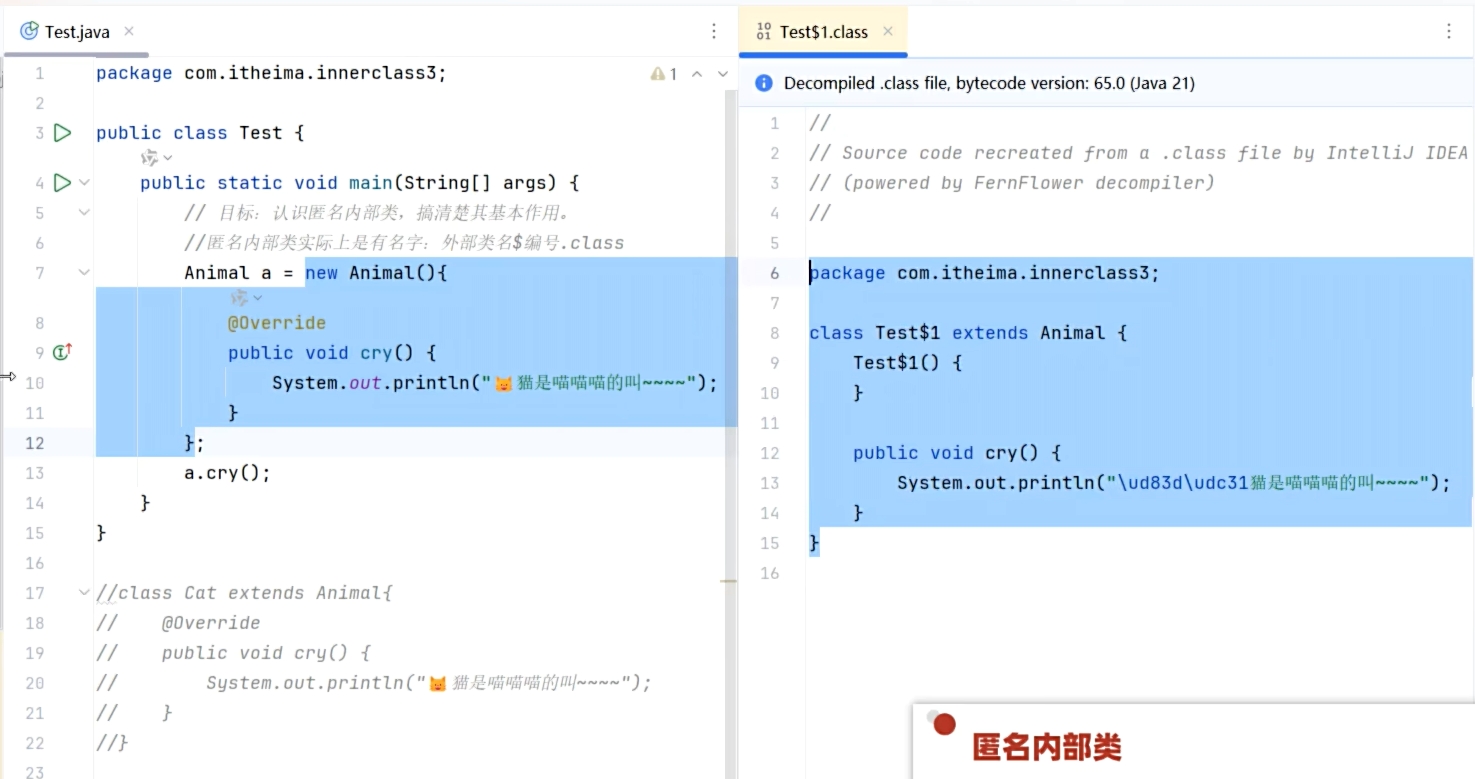面向对象学习27 - 内部类
内部类
成员内部类是什么? 如何创建其对象?
就是类中的一个普通成员,类似前面我们学过的普通成员变量、成员方法
外部类名。内部类名 对象名 = new 外部类 (...).new 内部类 (...);
成员内部类的实例方法中,访问其他成员有啥特点?
可以直接访问外部类的实例成员、静态成员
可以拿到当前外部类对象,格式是:外部类名.this。
代码示例
package com.itheima.innerclass;
public class Outer {
public static String schoolName = "黑马程序员";
private int age;
public static void test() {
System.out.println("test()");
}
// 成员内部类:无 static 修饰,属于外部类的对象特有
public class Inner {
private String name;
// 无参构造器
public Inner() {
System.out.println("Inner() name = " + name);
}
// 有参数构造器
public Inner(String name) {
this.name = name;
System.out.println("Inner(String name)");
}
public void show() {
System.out.println("show");
// 访问外部类静态成员
System.out.println(schoolName);
// 访问外部类静态方法
test();
// 访问外部类实例成员
System.out.println(age);
}
public String getName() {
return name;
}
public void setName(String name) {
this.name = name;
}
}
}
package com.itheima.innerclass;
public class InnerClassDemo1 {
public static void main(String[] args) {
// 演示 Outer 类的成员内部类 Inner 的创建与使用
Outer.Inner oi = new Outer().new Inner();
oi.setName("王麻子");
oi.show();
// 成员内部类访问外部成员的特点(拓展)演示
// 1、成员内部类中访问外部类成员(略,已在 Inner 类 show 方法体现)
// 2、成员内部类的实例方法中,拿到当前外部类对象:外部类名.this
People.Heart heart = new People().new Heart();
heart.show();
}
// 演示“外部类名.this”的 People 类,含成员内部类 Heart
static class People {
private int heartBeat = 100;
public class Heart {
private int heartBeat = 80;
public void show() {
int heartBeat = 200;
// 访问局部变量
System.out.println(heartBeat); // 200
// 访问内部类 Heart 的成员变量
System.out.println(this.heartBeat); // 80
// 访问外部类 People 的成员变量(通过 外部类名.this 语法)
System.out.println(People.this.heartBeat); // 100
}
}
}
}
代码说明
Outer 类:定义了静态成员 schoolName、test 方法,实例成员 age,以及成员内部类 Inner。Inner 类可直接访问外部类的静态成员、静态方法和实例成员。
InnerClassDemo1 类:main 方法中演示了两种成员内部类用法:
直接创建并使用 Outer 类的成员内部类 Inner,调用其方法验证对外部类成员的访问。
通过 People 类及其成员内部类 Heart,演示 外部类名.this 语法,用于在内部类中精准访问外部类的成员变量(区分局部变量、内部类成员变量、外部类成员变量)。
运行逻辑:执行 main 方法时,先创建 Outer.Inner 对象并调用 show,再创建 People.Heart 对象并调用 show,观察控制台输出即可验证成员内部类对外部类成员的访问规则 。
静态内部类
有static修饰的内部类
声明格式为:外部类名.内部类名 对象名 = new 外部类.内部类(...);
可以直接访问外部类的静态成员,不能直接访问外部类的实例成员
代码示例
@Data
@AllArgsConstructor
@NoArgsConstructor
public class Outer{
public static String schoolName;
private int age;//实例成员
//静态内部类:属于外部类本身持有
public static class Inner{
private String name;
public void show(){
System.out.println(schoolName);
//静态内部类中是否可以直接访问外部类的静态成员? 可以!
System.out.println(age);//报错
//静态内部类中是否可以直接访问外部类的实例成员? 不可以。
}
}
public class InnerClassDemo2 {
public static void main(String[] args){
Outer.Inner inner - new Outer.Inner();
inner.show();
}
}
匿名内部类
1、匿名内部类的书写格式是什么样的?
new 类或接口(参数值...){
类体(一般是方法重写);
};
举例:
new Animal(){
@Override
public void cry(){
}
};
2、匿名内部类的特点?
匿名内部类本质上是一个子类,会立刻创建出一个子类对象


3、匿名内部类的基本作用?
可以更方便的创建出一个子类对象。
代码示例
public abstract class Animal{
public abstract void cry();
}
public class Test{
public static void main(String[] args){
Animal a = new Animal(){
@Override
public void cry(){
System.out.println("🐱猫会喵喵喵的叫~")
}
};
a.cry();//🐱猫会喵喵喵的叫~
}
}
匿名内部类代码展示
//老师学生游泳比赛
interface Swim{
void swimming();//游泳方法
}
//传统方案使用实现类对接口进行实现
class Teacher implements Swim{
public void swimming(){
System.out.println("老师🏊狗爬式游泳~~~");
}
}
class Student implements Swim{
public void swimming(){
System.out.println("学生🏊自由式游泳~~~");
}
}
//使用匿名实现类对接口进行实现
public class swimTest{
// 声明 start 方法
public static void start(Swim swimmer) {
System.out.println("比赛开始!");
swimmer.swimming();
System.out.println("比赛结束!");
}
public static void main(String[] args){
Swim s1 = new Swim(){
@Override
public void swimming(){
System.out.println("学生🏊贼快");
}
};
start(s1);
System.out.println("============================================");
Swim s2 = new Swim(){
@Override
public void swimming(){
System.out.println("老师🏊贼溜");
}
};
start(s2);
}
}
//学生列表排序
package com.itheima.innerclass3;
import lombok.AllArgsConstructor;
import lombok.Data;
import lombok.NoArgsConstructor;
@Data
@NoArgsConstructor
@AllArgsConstructor
public class Student {
// 姓名 年龄 身高 性别
private String name;
private int age;
private double height;
private char sex;
}
import java.util.Arrays;
// 注意:如果使用的是 IDEA 等开发工具,需确认已正确安装并启用 Lombok 插件,否则可能编译报错
public class Test4 {
public static void main(String[] args) {
// 目标:完成给数组排序,理解其中匿名内部类的用法。
// 准备一个学生类型的数组,存放 6 个学生对象。
Student[] students = new Student[6];
students[0] = new Student("殷素素", 35, 171.5, '女');
students[1] = new Student("杨幂", 28, 168.5, '女');
students[2] = new Student("张无忌", 25, 181.5, '男');
students[3] = new Student("小昭", 19, 165.5, '女');
students[4] = new Student("赵敏", 27, 167.5, '女');
students[5] = new Student("刘亦菲", 36, 168, '女');
@Override
public int compare(Student o1, Student o2) {
// 指定排序规则:
// 如果你认为左边对象 大于 右边对象 那么返回正整数。
// 如果你认为左边对象 小于 右边对象 那么返回负整数。
// 如果两边相等那么返回0。
return o1.getAge() - o2.getAge(); // 按照年龄升序!
}
// 遍历数组中的学生对象并输出
for (int i = 0; i < students.length; i++) {
Student s = students[i];
System.out.println(s);
}
}
}






 浙公网安备 33010602011771号
浙公网安备 33010602011771号